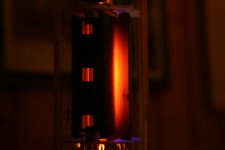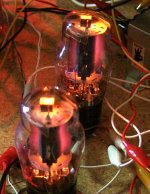Recently been asked to have a look at a V6 Manley amp and found this KT90 radiating quite well. All the other KT90 tubes in the amp (5off) are running with near sim conditions. Checked bias components and volts on all p-p o/ps. Swapped tubes around and this one persists in glowing but very one sided and in the centre.
Screen and anode volts identical. Why the glow. Any explanation ?
richj
Screen and anode volts identical. Why the glow. Any explanation ?
richj
Attachments
Umm quality control?
Perchance that the tube is a dud?
Does it sound different?
And no matter where it is it glows whereas others dont?
Nick
Perchance that the tube is a dud?
Does it sound different?
And no matter where it is it glows whereas others dont?
Nick
Are the tubes made by Ei?
Jim McShane (tube dealer, generous contributor here and on AA) has documented many times the glowing plates in Ei KT90 due to quality issues. He used to recommend them in his Citation rebuilds, but no more.
Rod
Jim McShane (tube dealer, generous contributor here and on AA) has documented many times the glowing plates in Ei KT90 due to quality issues. He used to recommend them in his Citation rebuilds, but no more.
Rod
richwalters said:Recently been asked to have a look at a V6 Manley amp and found this KT90 radiating quite well. All the other KT90 tubes in the amp (5off) are running with near sim conditions. Checked bias components and volts on all p-p o/ps. Swapped tubes around and this one persists in glowing but very one sided and in the centre.
Screen and anode volts identical. Why the glow. Any explanation ?
The glower looks to be gassy. The negative control grid attracts positive ions, negating the grid bias, and that's the result. Sometimes you can actually see the glow filling the space between the cathode and plate, but not always. I had a couple of gassy 6BQ6GTBs that looked OK, but the bias would not settle down, and those also glowed, but not quite so bad, but more than enough to be a big concern. Tube tester confirmed the gassy condition.
As for why that glow only occurs in some places but not others, the g(m) stated in the spec sheet is an average over the entire plate. In practice, some regions have a higher g(m) than others due to irregularities in the cathode, the electric field due to a non-cylindrical geometry, irregularities in the grids. The spots where the g(m) is highest are going to get hotter.
In practice, some regions have a higher g(m) than others due to irregularities in the cathode, the electric field due to a non-cylindrical geometry, irregularities in the grids. The spots where the g(m) is highest are going to get hotter.
I have dissected some sick, dying, or already dead tubes and found exactly this. The usual culprit is bent grid rods causing uneven spacing between the electrodes. All of the plate current flows in the region that you see glowing red. I have also found bent cathode assemblies and warped plate structures. I have found this on brand new tubes from some popular manufacturers. I have also found grids where the diameter or spacing varies along the length of the grid.
One of the usual tests I do to determine the build quality of a tube is to crank up the dissipation until it glows and see how evenly the heat is dissipated. A picture like yours is indicative of a tube that will not last long. The picture below shows a pair of cheap ($4 each) Chinese 6L6GC that is operating at 44 watts of dissipation. Note the even glow that is distributed along the plates without hot spots. These tubes were used (in a guitar amp) when I got them. I have subjected them to "tests" like this many times, and I use them to experiment on whenever testing out any new circuits. The picture is two years old, and the tubes are still going strong.
I would suspect that your KT90 is just poorly built.
Attachments
I would suspect that your KT90 is just poorly built.
AMEN! Jim McShane documented the problems with misaligned screen grids, on more than 1 occasion. 🙁
When properly made, the EI KT90 was a fine tube. Unfortunately, the specimens produced in the time frame before the plant closed were anything but properly made.
Thanks for replies. The tube is an Ei make and came out of an amp in bass box, so perhaps vibration played a part of the destruction. However, thd measurements (very high 5%) and a rap test indicate a microphonic loose grid and this is prob the culprit.
Corrrect...bin it.
richj
Corrrect...bin it.
richj
That KT-90 is exhibiting the CLASSIC misaligned screen symptoms. If you could look through the holes in the plate you'd also see a bunch of white hot screen wires... I saw one KT-90 that literally lit up a room like a 25 watt bulb from the white glowing screens.
That's the way that tube was built - it wasn't damaged. In my last batches of KT-90s from Ei over 95% had that exact problem right out of the box.
The type III is the only series to have the problem, the type I and II did not have it. There WERE some good type IIIs made - but after the NATO intervention in the late 90s the quality was gone.
Toss those in the trash and install the Genalex reissue KT-88s.
Edited to add: Eric Barbour and I were discussing this problem when it first surfaced; he turned me on to the fact that the misaligned screens were the same problem he found in the early Svetlana 6550s (the late 90s tubes with round holes in the plates). The later Svetlanas (now SED in the USA) have square holes in the plates - those were for a special alignment tool used at the factory to get the screens properly aligned. End of red plates...
That's the way that tube was built - it wasn't damaged. In my last batches of KT-90s from Ei over 95% had that exact problem right out of the box.
The type III is the only series to have the problem, the type I and II did not have it. There WERE some good type IIIs made - but after the NATO intervention in the late 90s the quality was gone.

Toss those in the trash and install the Genalex reissue KT-88s.
Edited to add: Eric Barbour and I were discussing this problem when it first surfaced; he turned me on to the fact that the misaligned screens were the same problem he found in the early Svetlana 6550s (the late 90s tubes with round holes in the plates). The later Svetlanas (now SED in the USA) have square holes in the plates - those were for a special alignment tool used at the factory to get the screens properly aligned. End of red plates...
- Status
- Not open for further replies.
- Home
- Amplifiers
- Tubes / Valves
- KT90 why this ?

